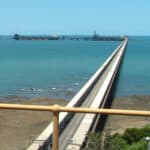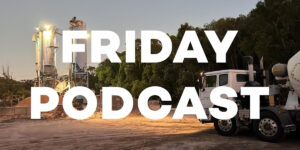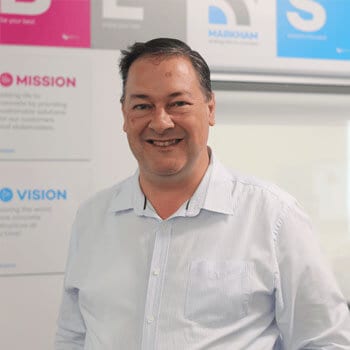In this very practical segment, Mike shares pointers from his past experience in infrastructure remediation. Project-specific specification; performance warranties; and the challenges of working on heritage structures. Mike explains the benefits of a joint manufacturer-contractor warranty; the importance of preventing failure, from the front end of the project; and the drawbacks of a ‘5 by 5 warranty’! And in passing, he’s helping get the bridges over the Brisbane River into shape before the Olympics – got to have them looking good!
Lessons in Infrastructure Remediation

Invisible Strength
Lessons in Infrastructure Remediation
/
RSS Feed
Lessons in Infrastructure Remediation
View the Transcript
BRENDAN: G’day everybody! Great to have you listening again to MARKHAM’s Invisible Strength podcast series, Next Level! And today we’re privileged to be joined by Mike Rutherford of Conspectus. Mike is an asset maintenance professional, with over 30 years’ experience in a wide array of industry segments. He’s worked on projects in both the United Kingdom and Australia, holds a place on the board of ACRA, the Australian Concrete Repair and Remedial Building Association.
Mike, welcome aboard. And could you give us some information on your own background and experience?
MIKE: Thank you for the introduction. I guess my background… I’ve been very, very lucky in the fact that I’ve done time in manufacturing and product development; I’ve done time in contracting with a tier one contractor; and also the consultancy aspect, so I’ve seen the industry from three different sides. So the experience – you know, it’s not a job, it’s been a career. It’s been a long time; and a lot of lessons learned on the way. And I guess now it’s a matter of passing those lessons on to the likes of facility owners and operators and, you know, even the likes of residential. So yes, it’s been an interesting journey, and a lot of changes in those, let’s say, 30-plus years!
BRENDAN: Yes, fair enough. That’s good. Can you tell us a little bit about your work in condition assessment, and follow through? I think you were mentioning your work on heritage structures and such. Is that your …?
MIKE: Yes, we do a lot of diversified consultancy work. I think probably the biggest segment that we’re involved with is in infrastructure, where we’re engaged to go out and do a condition assessment on steel and concrete. Corrosion audit. Concrete coatings, steel coatings. We then put that into a condition assessment corrosion audit report, make recommendations. When those recommendations are accepted, we turn around and develop a project-specific specification that can be used for the tendering. That puts everybody on the same page. Over the past years, a lot of work has gone to design-and-construct, but from our perspective we now see it going back to the likes of project-specific specification. And with that, there’s a lot of facility owners, and operators that… in the tender document, we don’t mention brand names or products. We mentioned product types, which sort of leaves it open for manufacturers to put up suitable systems for the tender.
We then get involved in the tender meeting to cover technical aspects; and then once the project started, we’re engaged to do the project quality services. Like, we do a commissioning ITP for the client, covering all points to the specification and all sorts of requirements.
On the heritage side…
I’ll just rewind back to the infrastructure side, I think. There there’s a realisation now that our infrastructure is under more demand than what it was initially designed for. And maybe asset maintenance may have been a little bit on the downside. So there’s a lot of work to be done, because we can’t just turn around and replace water treatment or sewage treatment plants. The remediation is a big part of that.
The other part of the market segment that we’re heavily involved in is, like in my background there, heritage bridges. You know, we’ve got bridges that are, yes, around Brisbane, that are over 90 years of age. They’ve got to be protected. Most of them have protective coatings or systems on them now; predominantly which is the first stage, being a siloxane impregnation system; and then an anti-carbonation system over the top. That bridge in the background is the Storey Bridge. We were originally involved in that back in the manufacturing and product development days. That was about 30 years ago. It’s now at the stage where it is now going to get a recoat. We can’t do coating removal to do a recoat, because we lose the heritage fabric if we take any of the surface of the concrete off. So once again, that throws up a lot of challenges.
So yes, but it’s all very interesting work. And you know, with the bridges over the Brisbane River, we want them all looking nice for the Olympics! We’ve got our work cut out for the next decade!
BRENDAN: Very good. Yes, it does… definitely sounds like very interesting work. Yes, the detail involved; and as you say, not damaging that heritage fabric.
Dig in, if you would please, on that term you used about ‘project-specific’ specifications. It’s like, you might say, obvious, and yet there’s more to it than meets the eye. Can you tell us about them and why they’re…?
MIKE: With larger projects, you know, we… with water projects, with underwater services, we’re under WSAA guidance as to what systems to use. In other projects – we’ve had a couple like the bridge works: perfect example; and we had another one with Dan, Radial Gates where we put out an expression of interest to manufacturers to say, well, OK, this is what we’ve got; this is what we want to do. And please make your recommendations.
We’ve done that in water and sewerage with cementitious and epoxy or cross-linking type chemistry products: we go to the manufacturer, they come back to us with their recommendations. We overview the recommendations that they that they come up with; they’re fully aware of the of the application and what the exposure is, the environment. It’s like the old saying; what works in a laboratory in Sydney doesn’t necessarily work in Cairns in a tropical marine environment.
From there, we’ll go to do product trials. Each manufacturer will come in – not on the same day, of course! – and they’ll do a trial area. We’ll do, like, concrete… We’ll do the surface preparation, ready to go. The manufacturers come in, they do their trial. Then we do the likes of adhesion tests; gloss; and depends what the client wants. It’s all fair in that aspect. But then again, with the likes of a lot of water authorities, we’re restricted to WSAA, where there’s no brand or product names, it’s a WSAA category. Like, say, 820 for epoxy novolak or whatever. So manufacturers of epoxy novolaks can put into that.
Now, with the project-specific specification, one of the things we do ask for – and I think it’s been sadly overlooked over the last decade – is performance warranties. We go to the manufacturers and say OK, give us a draft warranty. You know what the application is, this is the product that you’ve recommended. So we need that supported with a draft warranty, for whatever the clients chasing. And that can be, you know, anything up to 10 years to 1st maintenance, 15 years to 1st maintenance.
And then, on the other side of the coin. we go to the contractor; he puts the warranty on his workmanship. So the client gets a joint manufacturer-contractor warranty. We do put a clause in there that the contractor has to be accredited and trained; and the operators have to be trained by the manufacturer of that product; and the contractors will have a minimum of five years’ experience in similar applications. So that becomes project-specific because no two projects are the same. You know we can’t just do one generic spec and say that’s, one size is going to fit all. And, like, we’ve had instances where we’ve asked contractors for the specification, manufacturer specification and we’ve been handed a product TDS. Well, the TDS isn’t a specification, it just gives you an outline; and if you read the disclaimer at the bottom, yes, it doesn’t really carry much weight.
BRENDAN: Yes, that’s fair enough. Absolutely. And yes, that’s something that’s important to us too, about performance warranties, as opposed to just saying, here’s another bucket of the same product.
MIKE: Exactly. It’s an insurance policy for the client.
BRENDAN: Yes, that’s good. That’s a good way to put it. And…
MIKE: Yes, it works well and like you know, it’s a commitment for the manufacturer. They’re fully aware of what the application is, where the product is going, and what it has to do. And as I said, with that project-specific specification, that does help. Does help if it’s, you know, supported by the manufacturer with the warranty.
BRENDAN: Yes, very good. And I guess a fairly key point which we were going to talk about this, can you comment on industry ‘loss of memory recall’. It was an expression used with, probably in planning for this little chat. Forgetting past lessons.
MIKE: Yes. Look, I think if you have a look at the failures that we have in concrete remediation and concrete protection especially… You know, in my opinion, they’re all preventable, but we have applications where we have specifications for doing a repair with a polymer modified cementitious product, and then the next day we put an epoxy coating over the top and then we get a failure, just like we did the year before, the year before, and we have for the last decade. That once again goes back to the likes of the the project specification, manufacturer supported project specification where, you know, we aim to, wherever we can, to use a single source of supply. So in other words, we don’t have one manufacturer’s product being overcoated or used right next to another manufacturer’s product; but this has been done in the past and warranties have been offered. But they’re pretty hollow warranties; what we term as a 5 by 5 warranty, 5 minutes or 5 kilometres! That’s what it boils down to, if you know what I mean, and being a little bit sarcastic on that one.
But you know, have we learned from the lessons of the past? I think we have in a lot of instances. Like, you look at failures, let’s say for argument’s sake we go into water treatment and we realign sedimentation basins or filters; and it’s not all that easy just to take it offline to rectify or remediate something that could have been prevented. So it’s far better philosophy to get it right the first time. So we go back at the front end and make sure it’s all OK and we have the ITP’s like I mentioned, the commissioning ITP’s, it covers all aspects of the project from commencement or pre-start meeting right through to completion. And like, even to that degree; if it’s in water – first thing on the ITP is certification of potable water approval AS4020. That’s the first thing on the ITP. You know, that’s quite often overlooked. We have had projects where they’ve been used in water and that hasn’t been thoroughly checked out. And in the end, at the end of the day, all had to be removed and redone, which means everything’s got to come offline. There’s cost involved with that. Got to be cleaned. What’s been put on has got to be removed. That can be very, very expensive and, like, in removing that, we end up going back to parent concrete. And parent concrete, the profile on that is generally pretty rough, you’re looking at CSP 8 or CSP 10, if we use hydro-demolition to take off a failed coating, or an incompatible coating. As I said, all preventable, and like we keep on saying, prevention is better than cure. Make sure you get it right at the front end. The importance of that can’t be stressed highly enough, in my opinion.
BRENDAN: That’s good. That’s good. I agree with you, it’s very important.
Could you tell us, is there any memorable projects that stick in your mind, and in your past experience, which you particularly enjoyed working with, or maybe which you particularly didn’t enjoy working with?!
MIKE: Oh, look, there’s probably a few! And I smirk when I say that because I’ve had projects where I’ve been engaged for four days and come out 204 days later! We’ve had projects let for concrete remediation and protective coating. Let’s say, the contractors’ qualifications weren’t quite there. So we went in to basically do a superintendent’s role to get that right. And once again, I get back to what works in the laboratory doesn’t necessarily work on site. Spray-application of an epoxy liner which looked good. It was going on probably about 250-300 microns; looked great on the wall. You go back five minutes later, and we had, not just sagging, but almost curtaining. You know, you could actually put your phone in a curtain. It was that much.
And then there’s the enjoyable ones where you do the condition assessment at the start, and you go right through to the completion of the project. Some of those projects can go on for quite some time. It’s really gratifying to get to the end and to look at what you started with, and what you ended with. And you know what work went into that. But yes, look – there’s quite a few memorable ones there. And you know… I can even go back to the, well, late 90s, and we had a smelter expansion where, I don’t know, there was probably about 35,000 litres of epoxy went into that. To save wastage, rather than mix and form and pour on site, we prefabricated epoxy pads. It’s for isolation of electrics, you know; it’s concrete related, but we prefabricated everything on site and the wastage factors were down around 1%. The previous job, in Bahrain I think, was about 180% wastage factor. So yes, there’s a lot of lot of interesting stuff in there. Just to pick out a couple makes it hard.
BRENDAN: Yes, that’s good.
MIKE: We’ve learned the lessons to make sure we don’t go down that track again.
BRENDAN: Interesting mix of experiences.
MIKE: Yes, very much so. And I must say that, you know, I spent three years based in the UK and covered Europe and Ireland; and a little bit of work in Dubai; and you know, we do take a lot for granted in Australia. Like, we don’t get freeze-thaw in concrete. I worked on the Channel Tunnel rail link. You know, that was interesting. The dry docks in Dubai. But you know, I get back to what I was saying before about what works in the lab… You know, we have the situation in Queensland where the tropical marine environment, you know, we can’t, we wouldn’t use the same product as we’d use in Tasmania, that takes 48 hours to cure at 15 degrees, when we have the likes of the high relative humidity and the high temperature. And I guess the big thing, too, is the concrete temperature, the surface temperature of the concrete – I push to do everything on falling substrate temperature.
But we’ve had products developed… like say, for argument’s sake, injection resins for concrete repair, structural injection resins. Trying to do that in North Queensland or out at Mount Isa is very, very difficult. Even if you do it at midnight, I guess the fact is, your pot-lifes weren’t there. So we went to manufacturers and said, well, you know, this is what we need. We need something that’s got a three-hour pot-life, you know, in North Queensland that we can inject. And OK, it’s in your product range. If you put that in Tasmania, it’ll probably take six months to cure or to go off. What we’ve got is, it’s different strokes, different products, for different applications. And I think that, you know, we can’t say well, we’ve got case histories in this. We always ask for case histories if we recommend a product; and getting case histories that come out of Europe and things like that, that’s fine. But I always ask for case histories that have come out of a tropical marine environment that we work in.
BRENDAN: Yes, that’s good. That’s very important. We’ll see that ourselves. What works in …
MIKE: You can’t have one size fits all.
BRENDAN: … in Geraldton doesn’t work in Melbourne.
MIKE: Exactly. Exactly. Yes.
BRENDAN: Or vice versa. No, that’s good. That’s really good.
MIKE: Yes, I think the biggest thing just from the manufacturing point of view. The biggest thing that I look for are two important things: firstly, technical support; and secondly, continuity of supply.
If you get into sizable project works, and you get a technical inquiry you don’t want to be waiting eighteen hours for a response to come out of the states, or Europe. The technical support is… that’s high on the weighted averages.
And continuity of supply. I know there’s been a lot of problems in the supply chain, raw materials and everything, but like, you know, if we’re on a large project and say, well, we want another 250 litres – ah well, it’s going to be a four weeks wait – well, you know, that can be pretty frustrating. So as I said, they’re probably, from the manufacturing point of view, they’re the two highly weighted averages, you know, on our books.
BRENDAN: It’s very key. Very key. That’s good.
And yes, I guess in closing, Mike, we very much appreciate your time. Can you tell us how to get on to you, if any of our listeners would like to get you involved in a project?
MIKE: Well, look, I’ve got a… I’m on LinkedIn, but the phone number is 0427 405 771. My email is [email protected], Conspectus as on the shirt. And we don’t have a website. Don’t go looking for it on the information superhighway because we’re not there. The phone ringing is enough to keep us going.
BRENDAN: Yes, that’s good. Glad to know you’re keeping busy. And yes, I can imagine it being a space that there’s plenty to do in. Very good, very much appreciated, and thank you very much for joining us today!
MIKE: Thank you for the opportunity!
Want to Contribute?
Feedback on our podcasts? Suggestions for future topics? Looking for more information on topics we’ve discussed? Send us a message – we’ll be in touch within a day or two.
More about MARKHAM
MARKHAM are dedicated to providing innovations for concrete and construction. Focusing on concrete waterproofing solutions, penetrating concrete sealers and durability treatments for concrete.
Podcast Categories
Latest Episodes

Doug & Laike Share Their Week – Western Australia, Christchurch, and a Focus on Low Carbon Concrete
Laike and Doug wrap up their week again with a 10-minute chat. They’ve each been

Doug & Henry Share Their Week – R&D, Melbourne Traffic, Basement Waterproofing, And ‘CONQOR Your Health’
It’s Henry’s turn to join Doug in the podcast studio – in person this time!

Doug & Laike Share Their Week – Seychelles, Readymix Plants, And A Bike Ride
Once again Doug and Laike sit down for a 10 minute recap from the week.
invisible strength podcast
The whole MARKHAM team is pleased to present you with our podcast series, INVISIBLE STRENGTH. In this series of interviews, we’ll walk through the science and challenges of concrete durability, what goes wrong in the field – and the advanced methods available to restore and enhance service life to concrete construction.
INVISIBLE STRENGTH reflects a number of factors in concrete construction and durability. When things go wrong, the evidence can become very visible indeed. However, when all is going well, there’s nothing particular to be seen!
MARKHAM’s concrete treatments, too, are invisible once completed – and the result is the long internal, invisible durability of the concrete.
So join us as we explore the unseen world inside concrete – why it matters, and how it can be protected!

